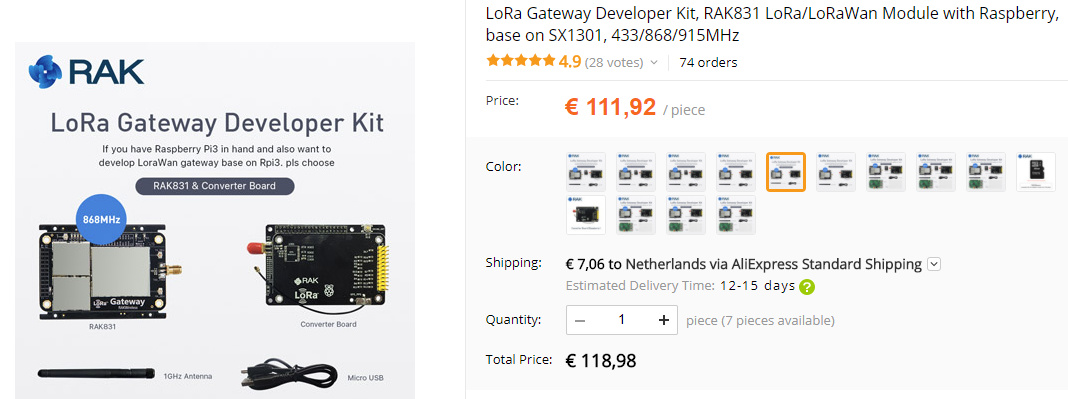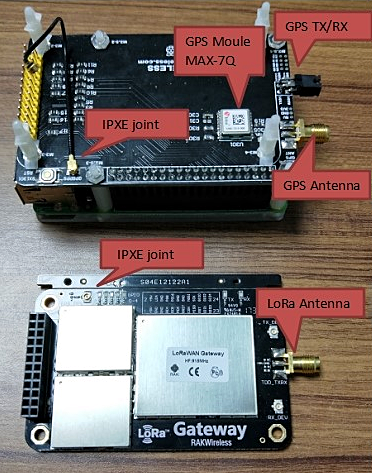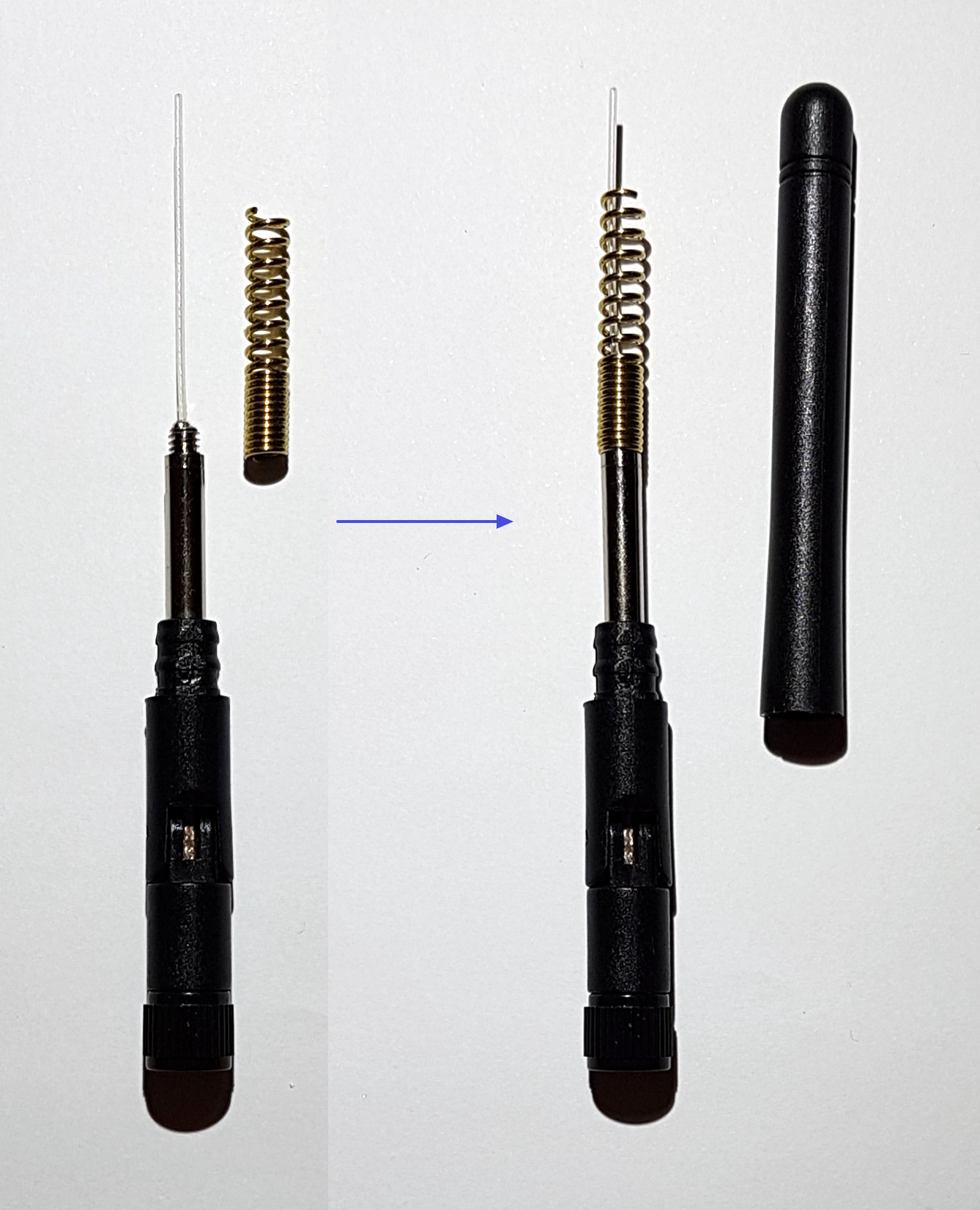I agree as I have very reliable signal from high ground 15km from my gateway but the RSSI can lower than -121 or more if I recall correctly.
The RAK831 Datasheet (in addition to the SPI pins) lists the following pins:
LNA_EN_A
RADIO_EN_A
PA_G8
RADIO_EN_B
PA_G16
PA_EN_A
RADIO_RST
and 5 SX1301 GPIO ports: GPIO0 … GPIO4 (each with a corresponding status LED).
Are any of these pins used by the gateway software or is only the SPI interface used?
Would it be of any use to connect these (non-SPI) pins to the host controller (RPi)?
(Just asking because these pins are wired on RAK’s Raspberry Converter Board.)
I’m still waiting for my RAK831 board and not sure if GPS is required for the gateway or not (and which would be the best converter board to use with RPi 2/3).
RAK831 has an IPEX connector for connecting GPS time pulse.
I see no other connections (usually serial Rx/Tx) for connecting a GPS to the board.
Is only the GPS time pulse used for the gateway, but not any location data?
Or does the gateway software support location data and does the GPS have to be connected to the Rx/Tx pins of the (RPi) host?
Concentrators just take in the PPS. It is the packet forwarder running on the host PC (e.g. the RPi) that can be made to parse the NMEA data, but I don’t know if any packet forwarder supports this out of the box.
GPS is not required for a functioning gateway.
RAK831 is available in several combinations.
When ordering I unfortunately overlooked this specific combination: RAK831 + Raspberry Pi converter board (not including the Pi itself).

The photo shows GPS time pulse cable soldered onto the converter board. On the actual version it is connected with an IPEX connector (located near the reset switch).
@jmarcelino
Responding to The hard RAK831 cafe part 1
The GPS module used for the RAK ‘Converter Board for Raspberry’ is: U-blox Max-7Q
The latest version of the RAK Raspberry Pi Converter Board now has header pins/jumpers for GPS RX/TX.

(source: RAKWireless)
RAK831 and Raspberry PI with RAK Converter Board + GPS module.
RX/TX pins are located next to the GPS antenna connector.
What is the purpose of that RX/TX jumper?
I assume to connect the GPS module RX/TX pins to Raspberry Pi pins to make possible to communicate with the GPS and read location data. The jumper construction is for making the connection optional I guess.
(I have ordered a board but have not yet received it.)
For older versions of the converter board without RX/TX wired it will be relative easy to solder two wires from the GPS module to the 40-pin Raspberry Pi connector (if needed).
Ahh, ok, makes sense, since the PPS signal is for the RAK831, and if want to access GPS data from the RPI some connection needs to be made. Probably this.
I just got my rak831 with the vendor supplied raspberry pi 3 and the interface board. However it seems that the reset pin is not routed to the same GPIO port as is used on the ttn-zurich build. Couldn’t find out if it is routed to a different pin or not at all… Resetting it manually using the switch on the interface board gets a little bit irritant.
Never mind, looks like it is GPIO17 
Quick question to all those in this conversation who have attempted to set up and mount the RAK831 dev kit as a functioning gateway (i.e. high up with an external antenna or installed outside within a suitable housing).
How robust is the hardware?
I am keen to order the RAK831 as the price is great, but I am worried about the need to constantly maintain it (compared with an out of the box MatchX or equivalent).
I have a simple RPi + RAK831 using a Chinese antenna all mounted on my TV antenna pole in the east of Ireland. The climate here is “temperate” so temperature ranges little by comparison to continental Europe for example, maybe -6 to 25C max range in the main. Right now I can see that the Pi’s CPU is at 30.4C. It is a rainy climate so I think skill in weatherproofing will be more important than temperature tolerance of the concentrator board.
The setup uses PoE injected at 19Vdc beside a small switch in my loft then regulated to 5Vdc beside the gateway. Everything is housed in a IP67 plastic box which should have enough volume and surface area not to overheat in our summer. So far using @kersing’s uper easy to setup packet forwarder (resin.io) with 100% reliability and a great console to monitor/manage the gateway.
Some pictures and words HERE
HTH?
Garry
Thanks @GryKyo. A fantastic post on your Gateway too. It sounds like you have had little problems once the Gateway has been installed, which is great to hear.
It does highlight the differences between climates though, here in Perth Australia we regularly hit 40C for days at a time during the Summer so I had better have the internal temperature monitored, fans installed and perhaps a max temp shutoff function!
OK, so once again I declare that I am a mech engineer, not a programmer but you could run a small python or similar on your linux box, I guess a Pi.
From command line:
/opt/vc/bin/vcgencmd measure_temp
will return your Pi’s CPU temperature which can be used to operate a fan or even a stand alone fan/temp controller in the installation. Only issue with this is remoteness and no closed-loop I guess. I have some projects which use cURL to push messages via Pushbullet to mobile devices and Chrome for alarms and warnings, very handy for remote devices.
With regard to the packet forwarder it has a live log and a SSH terminal so very suitable for remote control/monitor of your gateway and seems very robust in the short while I am using it.
Garry
Antenna included with RAK831 (868MHz) board

This is a photo of the inside of the antenna (RP-SMA) included with my RAK831 (868MHz) board.
The antenna rattled when I picked it up. I opened it to see what was wrong and found that the coil had come loose, which I was able to fix.
@jezd The hard RAK831 cafe part 1 - #235 by jezd
who supplies the tall case?
ModMyPi Cyntech Modular Cases for RPi 2/3
Brochure: The Ultimate Raspberry Pi & Maker Store– The Pi Hut
Shop: Raspberry Pi Cases | The Pi Hut
Recent versions of this case have light pipes on both sides of the micro-SD slot so they are suitable for both RPi 2 and RPi 3. The brochure shows the older RPi 2 case which has light pipes for RPi 2 only (RPi 3 does fit in the older version but you would not see the LEDs).
During The Things Conference we are organizing a workshop on how to build a gateway, using the RAK831.
If you have some experience and want to help out with this workshop on February 1st, please send me a pm.
See ‘RAK RPi Converter Board apparently has bugs/lacks in wiring of GPS module and antenna’ in topic: RAK831's and its Pi converter board modifications
I replaced the RP-SMA antenna included with RAK831 with this 868MHz SMA antenna (standard quarter wavelength whip).
https://www.aliexpress.com/item/ALLISHOP-868Mhz-5dbi-Gain-OMNI-Antenna-SMA-Male-19cm-Rotatable-Omni-Wireless-Wifi-Antenna-SMA-Male/32771698006.html
(They show pictures of different antennas, the first picture - the antenna with single groove on top - is correct.)
In a simple test with a node about 2m distance from the gateway (node with same above antenna):
RSSI jumped from -45 to -25 and SNR stayed similar around 9 to 10. (Have not done any further testing.)
The included whip antenna (rated by RAKWireless as 1GHz) does not perform very well in the comparison. Replacing it with a better antenna (like the above) will get better results from the gateway.
_(I replaced the RP-SMA connector on the RAK831 with SMA so it doesn’t need a converter for SMA antenna and prevents (minor) converter losses.)